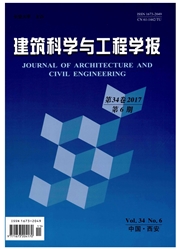

 中文摘要:
中文摘要:
采用DIANA有限元软件建立分离式钢筋混凝土梁模型,同时根据已有研究成果建立锈蚀钢筋及钢筋-混凝土界面的性能退化模型,通过试验验证了模型在锈蚀钢筋混凝土梁抗弯性能分析中的实用性。在此基础上,对锈蚀梁的梁拱作用转换和不均匀锈蚀梁的受力性能进行了数值模拟。结果表明:在钢筋端部锚固良好的情况下,剪弯段黏结破坏引起锈蚀梁的受力机制由梁作用向拱作用转换,且最终导致梁在使用荷载下的抗弯刚度降低34%~44%;纵向不均匀锈蚀梁的抗弯性能评价可简化为全跨均匀锈蚀梁,且计算承载力时宜取不均匀分布锈蚀率的最大值,计算刚度时宜取其平均值。
 英文摘要:
英文摘要:
A discrete finite element model was built using DIANA software, which was proved appropriate for analysis of flexural behavior of corroded reinforced concrete beams when combining with degradation model of corroded steel bars and steel-concrete interface through available research results. Further analysis was then carried on to investigate the transition from beam action to arch action of corroded reinforced concrete beams and flexural behavior of corroded beams with non-uniform corrosion distribution along longitudinal steel bars. The results show that the load carrying mechanisms of corroded reinforced concrete beams change from beam action to arch action if adequate anchorage is provided for tensile longitudinal steel bars, which is caused by bond failure in shear span and leads to decrease of flexural stiffness by 34%-44% under service load. Corroded reinforced concrete beams with non-uniform corrosion can be equated to uniformly full-span corroded beams in mechanical performance evaluation, the maximum value of the non-uniform corrosion distribution should be used for calculation of load carrying capacity, and the average value should be used for stiffness calculation.
 同期刊论文项目
同期刊论文项目
 同项目期刊论文
同项目期刊论文
 期刊信息
期刊信息
